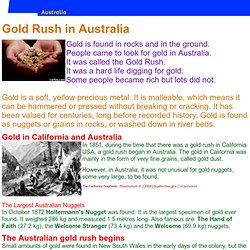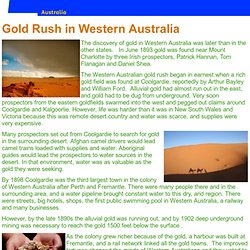

The Australian gold rush. JCF Johnson, A Game of Euchre, col. wood engraving, Australasian Sketcher Supplement [Melbourne], 25 December, 1876.

Image courtesy of the : nla.pic-an8927787. The gold rushes of the nineteenth century and the lives of those who worked the goldfields - known as '' - are etched into our national . There is no doubt that the gold rushes had a huge effect on the Australian economy and our development as a nation. It is also true to say that those heady times had a profound impact on the national psyche. The camaraderie and '' that developed between diggers on the goldfields is still integral to how we - and others - perceive ourselves as Australians. Indeed, mateship and defiance of authority have been central to the way our history has been told.
Even today, nothing evokes more widespread national pride than groups of irreverent Aussie 'blokes' beating the English at cricket, or any other sport for that matter! The discovery that changed a nation Gold frenzy A nation transformed Racism. Sovereign Hill Education - Research Notes. Welcome to Sovereign Hill Education Victoria’s 1850s goldrush heritage is alive, exciting and very hands-on at Sovereign Hill with creative, stimulating and interactive experiences for school students and kindergarten classes.

Students experience Sovereign Hill indoors, outdoors, above-ground and below-ground, giving a tremendous variety for school excursions and ensuring an action-packed, fun day. Sovereign Hill Education Sovereign Hill Education provides programs that are developed and delivered by Sovereign Hill Education officers, who are all experienced teachers. We provide unique on-site sessions, "Discover It Yourself" programs and education materials suitable for all students and designed to achieve Find out more Costumed Schools Program The Sovereign Hill Costumed School Program is a unique, two-day costumed role-play experience where children are fully immersed in the 1850s, learning about manners, costume, behaviour and re-living the discipline of school life on the goldfields. Gold!
Gold Rush in Australia Gold is found in rocks and in the ground.

People came to look for gold in Australia. It was called the Gold Rush. It was a hard life digging for gold. Some people became rich but lots did not. Gold is a soft, yellow precious metal. Ancient Australian History. After a long trek on foot or horseback by coach or dray from Sydney or Melbourne, new miners were thankful and excited when they reached the goldfields.

On the larger fields they saw hundreds or even thousands of tents clustered around creeks or near the site of earlier discoveries. There were horses and bullocks, wagons and carts and everywhere people bustling around, digging, panning, washing gravel, moving mounds of dirt or gently rocking their cradles from side to side. New miners soon realised, however, that the goldfields were not as attractive to live in as they looked from a distance. At Bendigo, for example, up to 40,000 people lived close together in tents. They did not have enough water and their toilets were simply holes in the ground. Miners worked hard day after day and often could afford neither the time nor the money to buy good food. The first diggers lived in tents which they brought with them to the goldfields. Gold Rush in Western Australia. Gold Rush in Western Australia The discovery of gold in Western Australia was later than in the other states.

In June 1893 gold was found near Mount Charlotte by three Irish prospectors, Patrick Hannan, Tom Flanagan and Daniel Shea. Gold Rush, 1852 : About New South Wales. © the State Library of New South Wales Following the first payable gold discovery at Ophir by Edward Hammond Hargraves in 1852, the international rush towards Australia's fledgling gold fields brought 370 000 migrants to Australia in its first year and would greatly alter the social and economic fabric of New South Wales. These new settlers brought with them new trades and skills, as well as their culturally specific habits, which benefited local economies of gold rush towns.
The towns also flourished with the development of sustainable service and manufacturing industries, elevating them beyond the somewhat stagnant farming villages of the past. When the gold rush came to an end in the 1870s, Australia's population had risen from 400 000 to 1.2 million, with many miners choosing to settle in Australia permanently.
Eureka! Chinese steelyard scale Mogo Gold Rush Theme Park Hill End Historic Site. Australian gold rushes. An Australian gold diggings circa 1855 After the California gold rush began in 1848, causing many people to leave Australia for California to look for gold there, the New South Wales government rethought its position, and sought approval from the Colonial Office in England to allow the exploitation of the mineral resources and also offered rewards for the finding of payable gold.[2] The first gold rush in Australia began in May 1851 after prospector Edward Hargraves claimed to have discovered payable gold near Bathurst, at a site he called Ophir.[3] Hargraves had been to the Californian goldfields and had learned new gold prospecting techniques such as panning and cradling.

Hargraves was offered a reward by both the Colony of New South Wales and the Colony of Victoria.